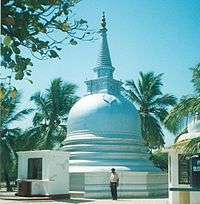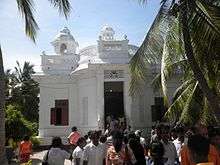Nagadeepa Purana Viharaya

Nagadeepa Purana Viharaya is an ancient Buddhist temple situated in Jaffna district of Northern Province, Sri Lanka. It is among the country's sixteen or seventeen holiest Buddhist shrines (Solosmasthana). According to contemporary history, the Gautama Buddha visited the site after five years of attaining Enlightenment to settle the dispute between two warring Naga kings, Chulodara and Mahodara.
Ancient history according to the Mahavamsa chronicles and the Tamil Buddhist epic Manimekalai mentions a gem-studded throne and a stone with the Buddha’s footprint at the island Nainativu, (also known as Nagadeepa) which pilgrims from India visited.[1]
History and development

The site is known as the place where Lord Buddha came during his second visit to Sri Lanka, after five years of attaining Enlightenment, to intervene and mediate in settling a dispute over the possession of a gem-studded throne.
When Buddha arrived and saw the Naga Kings prepared for fighting, Budhha used psychic powers to appear in the sky performing miracles. This made the Nagas astonished and happy. After having listened to the Dhamma sermons displaying Buddha's masterly knowledge of unity and harmony, meththa and compassion, the Naga kings paid homage to Budhha with overwhelming faith. The throne was offered to him in unison and they became pious devotees.
The Naga King Maniakkitha, ruler of Kelaniya, moved by the compassion of the Buddha, thanked him profusely for settling the dispute.
He further pleaded for a souvenir to worship and consequently the Buddha offered him the Kiripalu tree and the throne. A deity named Samiddhi Sumana, who had made the banyan tree his abode, accompanied him to Thathagatha while in Jetavanarama, holding the uprooted tree as an umbrella to him.
According to the golden Sannasa Wallipuram, committed to writing during the reign of king Vasabha, the temple was reconstructed by pious kings including Devanampiyatissa and Dutugemunu and converted into a sacred place. [2]
See also
- List of Archaeological Protected Monuments in Sri Lanka
- Ancient constructions of Sri Lanka
- Solosmasthana
- Buddhism amongst Tamils
Further reading
The first translation of Manimekalai by R. B. K. Aiyangar, was published in Maṇimekhalai in its Historical Setting.[3] Extracts of this were republished in Hisselle Dhammaratana's Buddhism in South India [4] A more recent translation of the poem was done by Alain Daniélou with the collaboration of T.V. Gopala Iyer [5] There is also a Japanese translation by Shuzo Matsunaga, published in 1991.
References
- ↑ "Sacred Island, Nagadipa". Buddha Dharma Education Association Inc / BuddhaNet. Retrieved 2011-09-13.
- ↑ "Tathagatha's visit to Nagadeepa". Daily News - The Associated Newspapers of Ceylon Ltd, Sri Lanka. 2009-03-25.
- ↑ Rao Bahadur Krishnaswāmi Aiyangar, Maṇimekhalai in its Historical Setting, London, 1928. Available at www.archive.org
- ↑ Hisselle Dhammaratana, Buddhism in South India, Kandy, 1964. Available online at Buddhist Publication Society Online Library Buddhism in South India.
- ↑ Alain Daniélou & Iyer, Manimekhalai: the Dancer with the Magic Bowl by Shattan, New York, 1989.